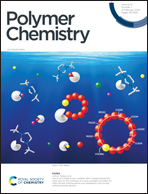Spiropyran-based polymeric micelles in aqueous solution: light-regulated reversible size alterations and catalytic characteristics†
Abstract
A well-defined triblock light-responsive amphiphilic copolymer with nitrospiropyran as the middle block was prepared by reversible addition–fragmentation chain transfer (RAFT) polymerization. The polymeric micelles obtained by self-assembling of the copolymer in water exhibited reversible size changes upon ultraviolet (UV) and visible (Vis)-light irradiation, owing to the transition between the closed three-dimensional spiropyran (SP) and the open planar merocyanine (MC) form, and the corresponding transformation of hydrophobicity and hydrophilicity. The hydrophobic SP form of nitrospiropyran resulted in a larger core diameter, showing higher dye adsorption ability in methyl red adsorption experiments. Upon UV irradiation, the transition of SP to hydrophilic MC caused a decrease of the core diameter, displaying a higher catalytic reaction rate in the Knoevenagel condensation reaction when base-functionalized micelles were applied. This work presented facile light-regulated reversible size changes of polymeric micelles. We expect that the light-regulated strategy developed here would be useful in the fabrication of smart nanoreactors for dye adsorption, catalysis, etc. in a controllable manner.



 Please wait while we load your content...
Please wait while we load your content...